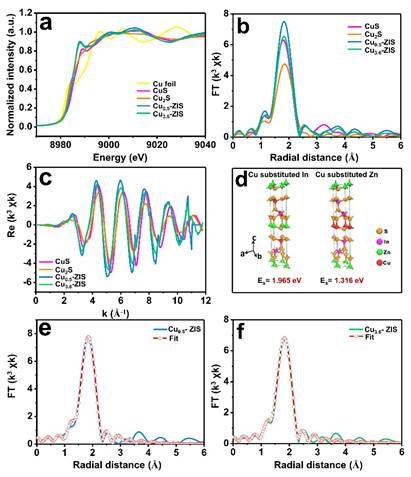| Atomic Insights for Optimum and Excess Doping in Photocatalysis: A Case Study of Few-Layer Cu-ZnIn2S4 |
| From: PublishDate:2020-07-29 Hits: |
The external heteroatom doping can form intermediate states in the gap or change the electronic structure to improve photocatalytic activities, which is a common strategy for improving the activities of traditional photocatalysts. However, the atomic structures of the optimum and excess doping and the mechanism of doping sites are still not explored. A team from college of Environmental Science and Engineering of Nankai university has gained insight into it. Their research has been published on January 7th, 2019 in Advanced Functional Materials. The research team synthesized the few-layer Cu-doped ternary sulfide ZnIn2S4 (ZIS) ultra-thin two-dimensional material at the atomic level, which was used as the model catalyst to reveal the origin of optimum and excess doping for photocatalysis through photocatalytic hydrogen production. Results show that the metal-S4 coordination maintains well with 0.5 wt% Cu substituted Zn atoms in the lattice. The introduced Cu atoms bring electronic acceptor states close to the valence band (VB) maximum and thus ensures higher charge density and efficient carrier transport, resulting in an optimum hydrogen evolution rate of 26.2 mmol h-1 g-1 and an apparent quantum efficiency of 4.76% at 420 nm. However, a distorted atomic structure and largely upshift of VB maximum with Cu-S3.6 coordination are found with excess doping concentration (3.6 wt%). These bring the heavy charge recombination and consequentially dramatic reduced activity. This work provides a new insight into elemental doping study and takes an important step toward the development of ultrathin 2D photocatalysts.
Using XAFS technique carried out at 1W1B-XAFS station of Beijing Synchrotron Radiation Facility (BSRF), the atomic structure of Cu-ZnIn2S4 and coordination environment of Cu dopants were obtained. The in-depth study of the optimum and excess doping mechanism at the atomic level is helpful to clarify the atomic behavior in the reaction process experimentally and theoretically, and it is very important for understanding the mechanism of the reactive sites. Results show that the peak positions of the Cu dopants (~ 1.8 ?) for different doping levels are very similar to that of the Cu atoms in CuS, but different from Cu2S, indicating a Cu-S bonding similar to that of CuS. The fitting parameters show that the Cu0.5-ZIS well maintains the metal-S4 coordination like that of pristine ZIS. While the Cu3.6-ZIS displays a Cu-S3.6 coordination region similar to that of CuS (Cu-S3.5).
The study revealed the optimum and excess doping structure on the atomic scale, and clarified the relationship between the structure and the photocatalytic performance. It also realized the controlled synthesis and regeneration of materials, further expanding the new strategy of doping engineering. In this research work, the synchrotron radiation light source helped the research team unravel the atomic level structure and coordination environment. Prof. Sihui Zhan, the leader of the research group and associate dean of the college of Environmental Science and Engineering of Nankai University described their work as follows: "The atomic structure and deactivation mechanism of heterogeneous atoms in doped catalysts are extremely complex, many related scientific questions have not yet been clearly revealed due to the limitations of characterization methods, so synchrotron radiation is becoming a powerful tool for studying nanomaterials and providing a broad platform for the characterization of nanomaterial structures and properties. " Article: Pengfei Wang, Zhurui Shen, Yuguo Xia, Haitao Wang, Lirong Zheng, Wei Xi, and Sihui Zhan*. Atomic Insights for Optimum and Excess Doping in Photocatalysis: A Case Study of Few‐Layer Cu‐ZnIn2S4, Adv. Funct. Mater., 2019, 29, 1807013. |
|
|
| Chinese
- Metal-free efficient photocatalyst for stable visible water splitting——Top ten major scientific progresses in China in 2015
- The nano-resolution imaging platform was awarded the first rate prize of Beijing Science and Technology in 2014
- Beamline 1W1 of BSRF started to runoperate in the couplingparasitic mode of BEPCII
- Synthesis of High Performance Polymer Materials for Field Effect-Transistors
- Surfactant molecular aggregates in green solvents
- GIXRD has played an important role in the characterization of organic thin-film transistors
Science Highlights
Home /
Copyright © 2011 - 2012 Beijing Synchrotron Radiation Facility



